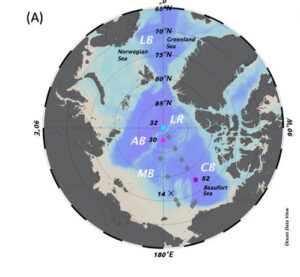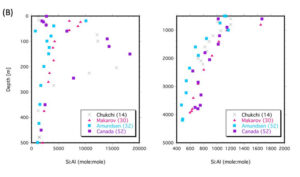New impetus to the debate on the sources of dissolved aluminium to the ocean
Based on the silicon/aluminium (Si/Al) ratio established along the 2015 U.S. Arctic GEOTRACES section (GN01), Measures and Hatta (2021, see reference below) put forth the hypothesis that the source of dissolved Al to the deep Arctic waters is from the resuspension of deposited sediments along the margins of the Arctic ocean. This significant set of data (15 vertical profiles for both parameters) reveal that the dissolved deep-water Si/Al ratios are low, ranging between ~ 500 and 700, in fact very much lower than the corresponding surface water values of ∼2,000–10,000. This decrease of Si/Al ratio with depth but increase in concentration is observed in the 3 arctic basins (Canada, Makarov, Amundsen were the Si/Al value is lowest). The authors propose in a detailed discussion what could explain this low ratio. They suggest that these materials are released from the products of reverse weathering produced within the sediments that is released into the low Si, low Al overlying water column by turbidity currents descending from the broad Arctic shelves which deliver this material as well as sediments and water into the bottom waters of the Arctic basins. In other words, their conclusions are challenging the paradigm that dissolved Al in the bottom waters of the Arctic basins could result from a top-down process, i.e. the water column remineralization of vertically transported biological material.


Figure: (A) Map showing the location of the sampling stations of the US Arctic GEOTRACES: CB, Canadian Basin; MB, Makarov Basin; AB, Amundsen Basin; LR, Lomnosov Ridge; LB, Lofoten Basin. The map was created using Ocean Data View software (Schlitzer, 2020).
B) Representative vertical profiles of the Si:Al ratio (mole:mole) in each of the basins and the Chukchi shelf of the Canada Basin occupied during the US Arctic GEOTRACES (GN01) cruise. Left panel shallow (0–500 m) depths right panel deep (500–5,000 m) depths. Numbers are the station numbers.
Reference:
Measures, C. I., & Hatta, M. (2021). On using Si to unravel potential sources of dissolved Al to the Deep Arctic. Journal of Geophysical Research: Oceans, 126(10). Access the paper: 10.1029/2021jc017399
